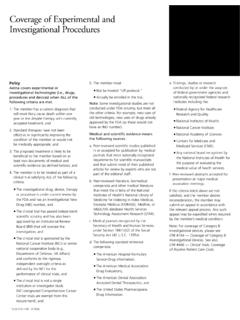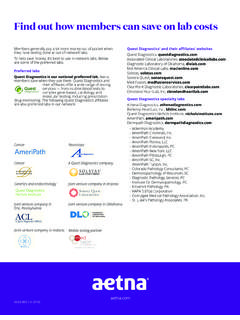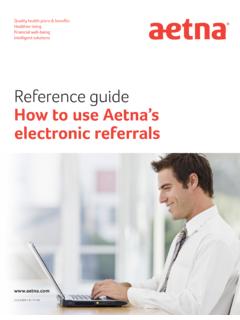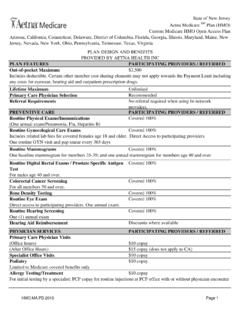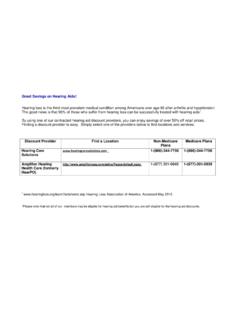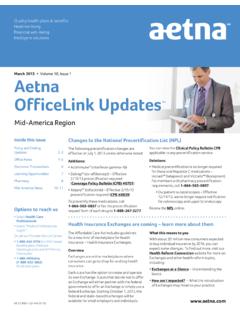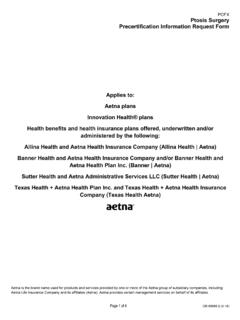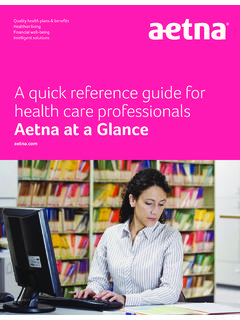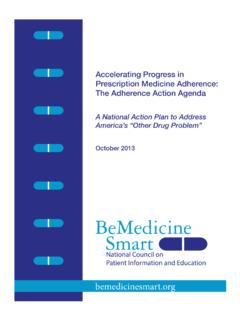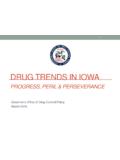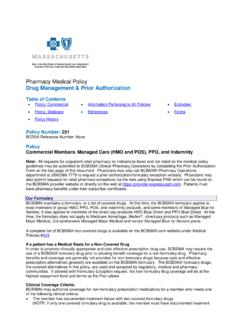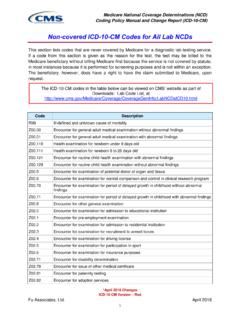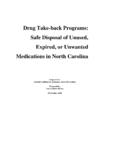Transcription of Aetna Compounded Drug Products Coverage Policy
1 Pharmacy ManagementIssued 01/2014 Updated: Annual Review: 10/2016 (12/16) Aetna Compounded drug Products Coverage Policy (Non -Medicare prescription drug Plan) PURPOSE: The pur pose of t his Policy i s to define Coverage criteria for Compounded drug Products . BACKGROUND: Pharmacist compounding of medication is the combination of the art and science of pharmacy. The pharmacist begins with the unique needs of the individual patient for a medication not commercially available in the strength, flavor, or dosage form required. Pharmacist compounding may be required: For preparation of a medication that has been withdrawn from the marketplace due to economicconcerns, NOT safety; For those patients that cannot or have trouble swallowing and require a concentrated liquid or arectal suppository; For those patients who have sensitivity to dyes, preservatives, or fillers in commercial productsand require allergy-free medications; For children who require liquid medicationsAccording to the FDA Compliance Policy Guide on Pharmacy Compounding, there is a list of factors that the FDA will consider in exercising its enforcement discretion regarding pharmacy compounding.
2 The FDA recognizes that pharmacists traditionally have extemporaneously Compounded and manipulated reasonable quantities of human drugs upon receipt of a valid prescription for an individually identified patient from a licensed practitioner. However, when the scope and nature of a pharmacy's activities raise the kinds of concerns normally associated with a drug manufacturer and result in significant violations of the Federal Food, drug and Cosmetic Act, the FDA has determined that is should seriously consider enforcement action. In determining whether to initiate such an action, the Agency has stated that it will consider whether the pharmacy engages in any of the following acts: 1. Compounding of drugs in anticipation of receiving prescriptions, except in very limited quantitiesin relation to the amounts of drugs Compounded after receiving valid Compounding drugs that were withdrawn or removed from the market for safety A provides a list of such drugs that will be updated in the future, as Compounding finished drugs from bulk active ingredients that are not components of FDAapproved drugs without an FDA sanctioned investigational new drug application (IND) inaccordance with 21 355(i)
3 And 21 CFR Receiving, storing, or using drug substances without first obtaining written assurance from thesupplier that each lot of the drug substance has been made in an FDA-registered Receiving, storing, or using drug components not guaranteed or otherwise determined to meetofficial compendia Using commercial scale manufacturing or testing equipment for compounding drug Compounding drugs for third parties who resell to individual patients or offering Compounded drugproducts at wholesale to other state licensed persons or commercial entities for 01/2014 Updated: Annual Review: 10/2016 (12/16) 8. Compounding drug Products that are commercially available in the marketplace or that are essentially copies of commercially available FDA-approved drug Products . In certain circumstances, it may be appropriate for a pharmacist to compound a small quantity of a drug that is only slightly different than an FDA-approved drug that is commercially available.
4 In these circumstances, FDA will consider whether there is documentation of the medical need for the particular variation of the compound for the particular patient. 9. Failing to operate in conformance with applicable state law regulating the practice of pharmacy. MEDICAL EXCEPTION Coverage Policy In the absence of a published Aetna Clinical Policy Bulletin to the contrary, Compounded drug Products are considered medically necessary if ALL of the following criteria are met: 1. The product contains at least one prescription ingredient AND 2. The prescription ingredient is FDA-approved for medical use in the United States AND 3. The Compounded product is not a copy of commercially available FDA-approved drug product AND 4. The safety and effectiveness of use for the prescribed indication is supported by FDA-approval or adequate medical and scientific evidence in the medical literature.
5 Note: Medical and scientific evidence is defined as any one of the following: Peer -reviewed scientific studies published in or accepted for publication by medical journals that meet nationally recognized requirements for scientific manuscripts and that submit most of their published articles for review by experts who are not part of the editorial staff. Peer -reviewed literature, biomedical compendia, and other medical literature that meet the criteria of the National Institute of Health's National Library of Medicine for indexing in index Medicus, Excerpta Medicus (EMBASE), Medline, or MEDLARS database Health Services Technology Assessment Research (STAR). Medical journals recognized by the Secretary of Health and Human Services, under Section 1861(t)(2) of the Social Security Act (42 1395x). The following standard reference compendia: DrugPoints System, American Hospital Formulary Service drug Information (AHFS-DI), MicroMedex s DrugDex, Clinical Pharmacology, and National Comprehensive Cancer Network (NCCN) drug & Biological Compendia Findings, studies, or research conducted by or under the auspices of federal government agencies and nationally recognized federal research institutes including the: Agency for Healthcare Research and Quality, National Institutes of Health, National Cancer Institute, National Academy of Sciences, Center for Medicare and Medicaid Services, and Any national board recognized by the National Institutes of Health for the purpose of evaluating the medical value of health services Issued 01/2014 Updated: Annual Review.
6 10/2016 (12/16) Peer -reviewed abstracts accepted for presentation at major medical association meetings. Thefollowing Compounded preparations are examples of preparations that Aetna considers to beexperimental and investigational, because there is inadequate evidence in the peer - reviewedpubli shed medical literature of their effectiveness: Bioidentical hormones (see Medical CPB 0388: Complementary and Alternative MedicineBioidentical hormones (see Medical CPB 0388: Complementary and Alternative Implantable estradiol pellets (see Medical CPB 0345: Implantable Hormone Verapamil topical cream (see Medical CPB 0007: Erectile Nebulized anti-infectives, nasal administration (see Medical CPB #593: Aerosolized Anti- infective Treatment for Ketamine topical gelAUTHORIZATION PERIOD AND LIMITATIONS: Initial Approval: 1 (ONE) year NON Coverage Policy : The following drugs/compounds are NOT covered: 1.)))))
7 Any drug coded as a pharmaceutical aid, such as bulk powders2. Any drug coded as OTCs3. Any compounding kits4. Compounded pain patchesREFERENCES: General Compounding Medical CPB #0388: Complementary and Alternative Medicine revised April 18, 2006; LA, Doering PL, Kipersztok S. Bioidentical hormone therapy: A review. Menopause. 2004; 11(3) Committee on Gynecologic Practice. ACOG Committee Opinion #322: Compounded bioidentical hormones. Obstet Gynecol. 2005; 106(5 Pt 1):1139 LA, Doering PL, Kipersztok S. Bioidentical hormone therapy: a review. Menopause. 2004 May-Jun; 1 1(3):356-67. Issued 01/2014 Updated: Annual Review: 10/2016 (12/16) Implantable Estradiol Pellets 6. Aetna Medical CPB #0345: Implantable Hormone Pellets revised June 23, 2006; 7. FDA Center for drug Evaluation and Research meeting of Pharmacy Compound Advisory Committee, October 14, 1998.
8 Page 51. NSAIDs in PLO (pluronic lecithin organogel) 8. Moore RA, Tramer MR, Carroll D, et al. Quantitive systematic review of topically applied non- steroidal anti-inflammatory drugs. BMJ. 1998; 316:333-8. 9. Sheu MT, Chen LC, Ho. Simultaneous optimization of percutaneous delivery and adhesion for ketoprofen poultice. In J Pharm. 2002; 233:257-62. 10. Ceschel GC, Maffei P, Lombardi Borgia S. Correlation between the transdermal permeation of ketoprofen and its solubility in mixtures of a pH phosphate buffer and various solvents. drug Deliv. 2002; 9:39-45. 11. Ozaki M, Minami K, Sata T, Shigematsu A. Transdermal ketoprofen mitigates the severity of postoperative sore throat. Can J Anaesth. 2001; 48:1080-3. 12. El-Kattan Af, Asbill CS, Kim N, Michniak BB. Effect of formulation variables on the percutaneous permeation of ketoprofen from gel formulations.
9 drug Deliv. :147 -53. 13. Hong JY, Lee IH. Suprascapular nerve block or a piroxicam patch for shoulder tip pain after day case laparoscopic surgery. Eur J Anaesthesiol. 2003; 20:234-8. 14. Cheong HA, Choi HK. Enhanced percutaneous absorption of piroxicam via salt formation with ethanolamines. Pharm Res. 2002; 19:1375-80. 15. Curdy C, Kalia YN, Naik a, Guy RH. Piroxicam delivery into human stratum corneum in vivo: iontophoresis versus passive diffusion. J control Release. 2001; 76:739. 16. Beetge E, duPlessis J, Muller DG, et al. The influence of the physicochemical characteristics and pharmacokinetic properties of selected NSAID's on their transdermal absorption. Int J Pharm. 2000; 193:261-4. 17. Cordero JA, Alarcon L, Escribano E, Obach R, Domenech J. A comparative study of the transdermal penetration of a series of nonsteroidal anti-inflammatory drugs.
10 J Pharm Sci. 1997; 86:503-8. 18. Ritchie LD. A clinical evaluation of flurbiprofen LAT and piroxicam gel: a multicentre study in general practice. Clin Rheumatol. 1996; 15:243-7. 19. Russell AL. Piroxicam topical gel compared to placebo in the treatment of acute soft tissue injuries: a double -blind study comparing efficacy and safety. Clin Invest Med. 1991; 14:35 -43. 20. Whitefield M, O'Kane CJ, Anderson S. Comparative efficacy of a proprietary topical ibuprofen gel and oral ibuprofen in acute soft tissue injuries: a randomized, double -blind study. J Clin Pharm Ther. 2002; 27:409- 17. 21. Machen J, Whitefield M. Efficacy of a proprietary ibuprofen gel in soft tissue injuries: a randomized, double -blind, placebo-controlled study. In J Clin Pract. 2002; 56:102-6. 22. Padilla M, Clark GT, Merrill RL. Topical medications for orofacial neuropathic pain: a review.
